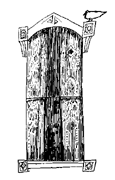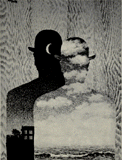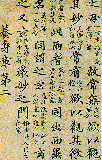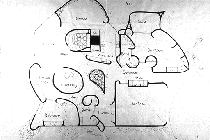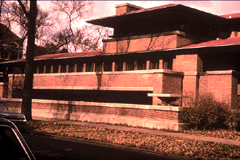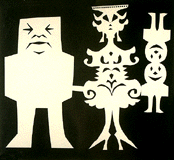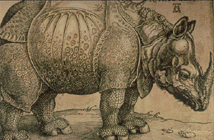The elements are components or parts which can be isolated and defined in any visual design or work of art. They are the structure of the work, and can carry a wide variety of messages.
The elements are:
Point
Even if there is only one point, one mark on a blank page there is something built into the brain that wills meaning for it, and seeks some kind of relationship or order, if only to use it as a point of orientation in relation to the outline of the page. If there are two points, immediately the eye will make a connection and "see" a line. If there are three points, it is unavoidable to interpret them as a triangle; the mind supplies the connections. This compulsion to connect parts is described as grouping, or gestalt.
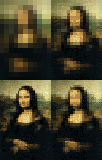
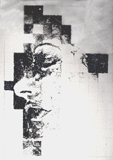 Gestalt is the fundamental tool the designer or artist uses to build a coherent composition. The example of a student self-portrait seen on the left demonstrates how images may be built from points, with the variations in density producing the illusion of form.
Gestalt is the fundamental tool the designer or artist uses to build a coherent composition. The example of a student self-portrait seen on the left demonstrates how images may be built from points, with the variations in density producing the illusion of form.
Gestalt theory developed in the 1920s in Germany. The term describes a number of concepts that the eye/mind use to group points into meaning. These include Closure, in which the mind supplies missing pieces to complete the image-- this occurs in the Mona Lisa images to the right. A second concept is continuity-- this describes the tendency to "connect the dots" and so accept separate parts or points as part of a contour or form. It is hard to resist, for example, the compulsion to see two dots as implying a line, or three as framing a triangle.Similarity describes the tendency to see and group objects of similar shape or color. Proximity results in a tendency to group points or objects that are close to one another relative to less proximate in the visual field. Alignment, either along edges of the objects or points or through their centers, will persuade us see them as a contour or a line.
The involuntary will-to-order that we impose on a collection of points can be clearly seen when we examine the series of faces presented on the right (to see the distortions properly, you will need to click on this small image to bring up the larger version). At what stage do the apparently random points of value become identifiable as a face? At what point do they become a specific face? Which of the concepts above describe how we see these images?
The Elements: Line
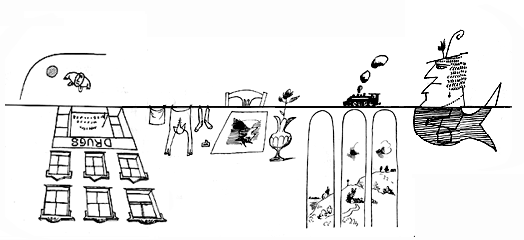
A line is a mark made by a moving point and having psychological impact according to its direction, weight, and the variations in its direction and weight. It is an enormously useful and versatile graphic device that is made to function in both visual and verbal ways. It can act as as a symbolic language, or it can communicate emotion through its character and direction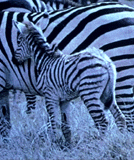
Line is not necessarily an artificial creation of the artist or designer; it exists in nature as a structural feature such as branches, or as surface design, such as striping on a tiger or a seashell.
It can function independently to suggest forms that can be recognized, even when the lines are limited in extent. This can be seen in drawings such as the Saul Steinberg illustration shown here, or in Alexander Calder's minimal wire sculptures, which convey a great deal of information about the figure with the most limited line.
Lines can be combined with other lines to create textures and patterns. This is common in engravings and pen and ink drawings such as the one on the right (click and enlarge to see linear detail). The use of line in combination results in the development of form and value, which are other elements of design.
However, line is not always explicit. It can exist by implication, as the edge of forms. As young children we usually begin drawing landscapes by making outlines for earth, sky, and other objects. Gradually we learn that objects do not have such outlines and we let color changes define the edges of shapes, creating implicit lines. Thus we can speak of a horizon "line," or the "lines" of a car or a fashion silhouette, even though we know there is no literal line present. For additional visual examples of
Expressive Qualities of Line
Certain arrangements of line are commonly understood to carry certain kinds of information.
For example, calligraphy is recognizable as a representation of words, even when we do not know the language. Calligraphic imagery is often used by modern artists simply because of the mysterious messages implied in the "code" of unknown language.
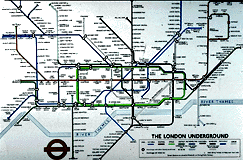 Line in the form of maps is readily recognized as a symbolic representation of a place. The place may be a local neighborhood, or the entire world. It may be a carefully measured representation, or a stylized diagram, such as a subway map. In either case, we understand it to be a device by which we can understand the relationship between places; how to get from "here" to "there."
Line in the form of maps is readily recognized as a symbolic representation of a place. The place may be a local neighborhood, or the entire world. It may be a carefully measured representation, or a stylized diagram, such as a subway map. In either case, we understand it to be a device by which we can understand the relationship between places; how to get from "here" to "there."
Floor plans are a specialized kind of map, a commonly understood device which describes a building. This linear language can be understood even when the building is as unusual as this one, which was to be constructed of a sprayed foam material in a decidedly unconventional form.
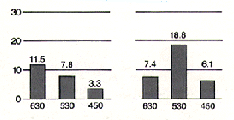 Graphs are another readily recognizable linear device. They are widely used to communicate quantitative information and relationships in a visual way. From the time we first meet them in basic algebra, to the last time we picked up a copy of USA Today, we encounter and interpret graphs.
Graphs are another readily recognizable linear device. They are widely used to communicate quantitative information and relationships in a visual way. From the time we first meet them in basic algebra, to the last time we picked up a copy of USA Today, we encounter and interpret graphs.
Line also communicates emotion and states of mind through its character and direction. The variations of meaning generally relate to our bodily experience of line and direction.
Horizontal line suggests a feeling of rest or repose. Objects parallel to the earth are at rest in relation to gravity. Therefore compositions in which horizontal lines dominate tend to be quiet and restful in feeling. One of the hallmarks of Frank Lloyd Wright's architectural style is its use of strong horizontal elements which stress the relationship of the structure to the land.
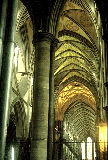
Vertical lines communicate a feeling of loftiness and spirituality. Erect lines seem to extend upwards beyond human reach, toward the sky. They often dominate public architecture, from cathedrals to corporate headquarters. Extended perpendicular lines suggest an overpowering grandeur, beyond ordinary human measure.
Diagonal lines suggest a feeling of movement or direction. Since objects in a diagonal position are unstable in relation to gravity, being neither vertical nor horizontal, they are either about to fall, or are already in motion, as is certainly the case for this group of dancers. In a two dimensional composition diagonal lines are also used to indicate depth, an illusion of perspective that pulls the viewer into the picture-creating an illusion of a space that one could move about within. Thus if a feeling of movement or speed is desired, or a feeling of activity, diagonal lines can be used.
Horizontal and vertical lines in combination communicate stability and solidity. Rectilinear forms stay put in relation to gravity, and are not likely to tip over. This stability suggests permanence, reliability and safety. In the case of the man in this family group, the lines seem to imply stability to the point of stodginess.
Deep, acute curves, on the other hand, suggest confusion, turbulence, even frenzy, as in the violence of waves in a storm, the chaos of a tangled thread, or the turmoil of lines suggested by the forms of a crowd. The complicated curves used to form the mother in the family group shown above suggest a fussy, frivolous personality.
Curved lines do vary in meaning, however. Soft, shallow curves suggest comfort, safety, familiarity, relaxation. They recall the curves of the human body, and therefore have a pleasing, sensual quality.
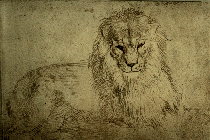 The quality of the line is in itself a fundamental visual language, to an extent that cannot be claimed for any other single element. Its use is so universal that we are all profoundly sensitive to it. Even without an artist's training, we can extract considerable meaning from the kind of line used in a drawing. It is possible to recognize the soft, irregular lines of a quick sketch from life, as seen in this study of a lion.
The quality of the line is in itself a fundamental visual language, to an extent that cannot be claimed for any other single element. Its use is so universal that we are all profoundly sensitive to it. Even without an artist's training, we can extract considerable meaning from the kind of line used in a drawing. It is possible to recognize the soft, irregular lines of a quick sketch from life, as seen in this study of a lion.
On the other hand, the crisp, carefully placed lines of the rhinocerous are typical of a more studied, scrupulously worked studio drawing. The lines suggest that this was not drawn from life, but from hearsay. This is also evident from the fact that Durer drew this rather inaccurate image in fifteenth century Europe when he could only have known of this African animal from travellers' tales.
The quality of line in itself contributes to the mood of the work, and for the master artist, the quality of line is a fundamental expression of his/her style.
Shape
Shape pertains to the use of areas in two dimensional space that can be defined by edges, setting one flat specific space apart from another. Shapes can be geometric (e.g.: square, circle, triangle, hexagon, etc.) or organic (such as the shape of a puddle, blob, leaf, boomerang, etc.) in nature. Shapes are defined by other elements of art: Space, Line, Texture, Value, Color, Form.
Form
Form may be created by the forming of two or more shapes or as three-dimensional shape (cube, pyramid, sphere, cylinder, etc.). It may be enhanced by tone, texture and color. Form is considered three-dimensional showing height, width and depth. Examples of these are sculpture, theatre play and figurines.
Space
Space is the area provided for a particular purpose. Space includes the background, foreground and middle ground. Space refers to the distances or areas around, between or within components of a piece. There are two types of space: positive and negative space. Positive space refers to the space of a shape representing the subject matter. Negative space refers to the space around and between the subject matter. Space is also defined as the distance between identifiable points or planes in a work of art.
Color
Color pertains to the use of hue in artwork and design. Defined as primary colors (red, yellow, blue) which cannot be mixed in pigment from other hues, secondary colors (green, orange, purple) which are directly mixed from combinations of primary colors. Further combinations of primary and secondary colors create tertiary (and more) hues. Tint and Shade are references to adding variations in Value; other tertiary colors are derived by mixing either a primary or secondary color with a neutral color. e.g. Red + White = Pink.
Texture
The texture is the quality of a surface or the way any work of art is represented. Lines and shading can be used to create different textures as well. For example, if one is portraying certain fabrics, one needs to give the feeling of the right texture so that it closely resembles what the artist is trying to convey.






